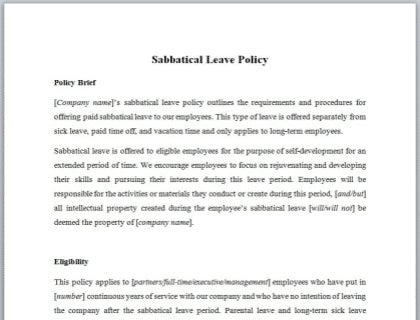
Sabbatical Leave Policy Template — Free Download
Download our sabbatical leave policy template in Microsoft Word and quickly tailor it to your company's needs.
Download NowWhat is a Sabbatical?
Originally, sabbatical leave was given to professors and university educators so that they could take off a semester or two of leave to further their education, teach at a foreign university, perform independent research, or write. However, more and more companies are offering their employees sabbatical leave to take a break from work.
A sabbatical from work is a full break during which employees are not expected to report to their employers or perform their normal job duties at all. However, the employee is still employed by the company. Some larger corporations offer sabbatical leave as a benefit for employees who have worked a specific number of years with that corporation.
Corporations and companies usually offer sabbatical leave of one or more months, depending on the individual company's policy and the number of years the employee has worked there.
Paid Sabbaticals vs. Unpaid Sabbaticals:
Paid Sabbaticals | Unpaid Sabbaticals |
|---|---|
The employer continues to pay the employee's wage. | There may be certain restrictions, like not doing other forms of paid work. |
Generally only offered to long-term employees. | Generally offered to employees who have worked at their company for a minimum period of time, usually 2 years. |
The company will pay the full salary or, more often, a percentage of the salary. | The employee's pension and benefits will be frozen for the sabbatical period. |
Benefits of a Sabbatical:
In financial terms, sabbaticals are a better option than the employee quitting their job as it will save the costs of recruiting and training a new employee.
Employees who take sabbaticals benefit from the time off by giving their minds a break from work, but they can also benefit the entire company by generating new ideas, innovations, and confidence in themselves. If a manager or supervisor takes a sabbatical, the employee who fills in for them gains valuable experience and skills.
In short, sabbaticals are helpful for developing talent and helping employees to return to work refreshed.
What Should a Sabbatical Leave Policy Look Like?
While sabbatical policies will differ between companies, each company should consider some basic issues, including:
- If the sabbatical leave will be a break from work where the employee can do what they want or if it will be for a specific reason, such as volunteering.
- How long an employee should work for the company before they qualify for a sabbatical (a basic rule of thumb for paid sabbaticals is a minimum of 5 years).
- Whether paid time off will count towards the minimum working period.
- How long an employee will have to accept the sabbatical leave before they lose the days. Most companies require their employees to use their time off before they become eligible for the next sabbatical.
- How often employees will be allowed to take sabbatical leave.
- If all employees will be eligible or only certain roles.
- Whether the time period for sabbatical eligibility will start from when eligible employees were hired or when they reached the eligible position, if applicable.
- If the employee will have to repay the sabbatical salary if they do not return to work after the leave period.
- If the sabbatical leave will be provided at the full or partial salary and, if at partial salary, how much it will be.
- What guidelines will be put in place for employees to request sabbatical leave.

